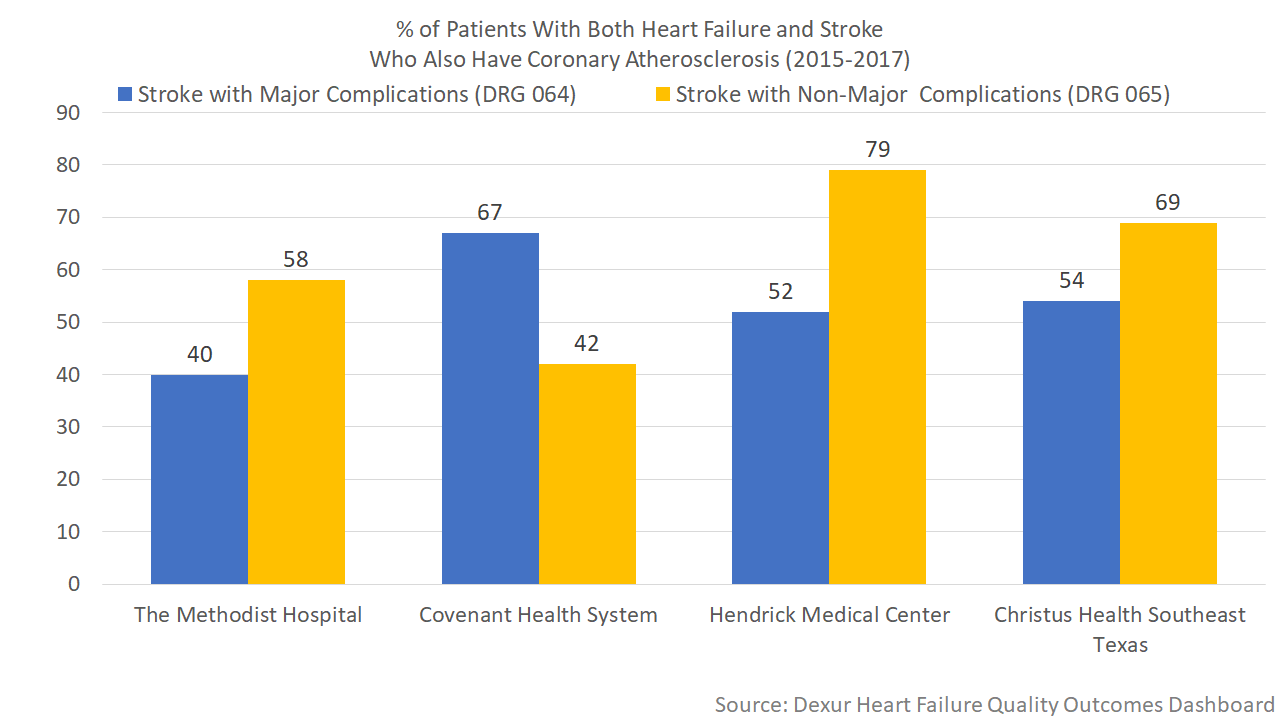Coronary Artery Disease Affects Half of Discharges With Comorbid Heart Failure and Stroke at Four Texas Hospitals
In Heart Failure
Get Dexur’s Personalized Hospital Specific Presentation on Quality, Safety, Compliance & Education
By: James Pitt Jun. 18, 2018
Coronary artery disease (CAD) is the leading cause of death in the US, killing approximately 370,000 people each year. (Coronary heart disease is a synonym). It occurs when plaque builds up in the arteries that feed the heart itself, a condition called coronary atherosclerosis.
One treatment is coronary artery bypass surgery (CABG), one of the most common surgeries in the US. As of 2011, about 213,700 coronary bypass surgeries were performed each year. CABG involves grafting vessels from elsewhere in the body onto the heart so that blood can flow through the grafted vessels rather than through obstructed vessels.
An important risk of CABG has reduced oxygen to the brain during the procedure, related to the risk of stroke. Up to 6% of all cardiac surgery patients may suffer strokes, and a 2014 study in Interventional Cardiac Review found that the risk of stroke after CABG had not decreased in the past ten years.
A possible way to reduce this risk is cerebral oximetry. Cerebral oximetry systems use near-infrared light to noninvasively measure cerebral oxygen levels. A randomized clinical trial found that cardiac surgery patients operated on using cerebral oximetry had a lower risk of permanent stroke, and reduced length of stay when patients were stratified by NYHA class.
Dexur analysts examined hospital-level data on Medicare-eligible inpatient discharges at four hospitals in Texas from October 2015 to June 2017. On average, about half of patients with heart failure and stroke also had coronary atherosclerosis.

Heart failure, stroke, and coronary atherosclerosis frequently co-occurred. At Covenant Health System (Houston, TX), 67% heart failure patients who experienced a stroke with major complications or comorbidities (DRG 064) also had coronary atherosclerosis; while 42% of heart failure patients who had a stroke with non-major complications or comorbidities (DRG 065) had coronary atherosclerosis.
On the other hand, DRG 065 patients had higher rates of coronary atherosclerosis than DRG 064 patients at Covenant Health System (Lubbock, TX), Hendrick Medical Center (Abilene, TX), and CHRISTUS Health Southeast Texas (Beaumont, TX). These trends did not change when patients who expired, were transferred or left against medical advice were excluded.

DEXUR PRO MEMBERS GET ACCESS TO:
- Total Discharges with DRG, Heart Failure & Coronary atherosclerosis
- Total Discharges after Exclusion with DRG, Heart Failure & Coronary atherosclerosis
- All Cause DRG, Heart Failure & Coronary atherosclerosis Readmissions
- All Cause DRG, Heart Failure & Coronary atherosclerosis Readmission Rate
- Total Discharges with DRG & Heart Failure
- Total Discharges after Exclusion with DRG & Heart Failure
- All Cause DRG Readmissions
- All Cause DRG Readmissions Rate
- Lift from DRG
- % of DRG & HF Discharges Who Have Atherosclerosis
- % of DRG & HF Discharges After Exclusion Who Have Atherosclerosis
For DRGs 064 and 065 from October 2015 to January 2017 for the below hospitals:
- The Methodist Hospital
- Covenant Health System
- Hendrick Medical Center
- Christus Health Southeast Texas (Saint Elizabeth Hospital)
ABOUT THE AUTHOR
